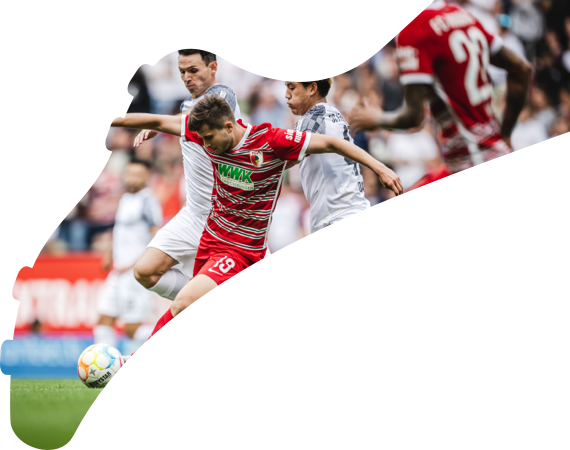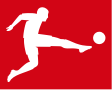
10 things on the Rhine derby between Borussia Mönchengladbach and Cologne
The Rhine derby between Borussia Mönchengladbach and Cologne is one of the most storied rivalries in the Bundesliga as two of Germany’s biggest clubs battle it out for regional supremacy.
Ahead of Cologne's trip to Mönchengladbach on Saturday, bundesliga.com runs you through 10 interesting facts about one of Germany's biggest match-ups...
1) You’re not even on the Rhine?
When you think of derbies, you think of same city or neighbouring cities, or major cities who have historically competed for status in a region. Well, there’s none of that here. With a population of over a million, Cologne is the largest city on the Rhine – bigger than the North Rhine-Westphalian capital of Dusseldorf 20 miles down the river. The city of Mönchengladbach is home to around a quarter of a million people, but no river. It is sandwiched between the Rhine and the Meuse in the Netherlands in an area referred to as the Lower Rhine.
Other clubs based on the Rhine to have played in the Bundesliga include Bayer Leverkusen, Fortuna Düsseldorf and Duisburg. There’s always an element of local rivalry when these teams meet, but none compare to the one between Cologne and Gladbach. The two most decorated clubs in the region, with two and five Bundesliga titles respectively, the pair have been clashing in their current forms (Cologne as we know them now were formed from a merger in 1948) since the 1950s.
Watch: The derby atmosphere in Cologne
Such is the level of rivalry nowadays that there was even a famous incident on a TV quiz show. In a July 2020 edition of Gefragt – Gejagt, the German version of The Chase, contestant and Gladbach fan Claus Blümel was in with a chance of winning €500 when asked “Which club won the Bundesliga 2 title in 2018/19?” He knew the answer but instead responded: “No, I’m not saying their name.” After the show went out, Gladbach gifted their ardent fan a jersey and also a voucher worth €500.
2) The Weisweiler derby
It’s around an hour’s drive between the RheinEnergieStadion and Borussia-Park, but one person links the two clubs, namely Hennes Weisweiler. The man whose name was given to the German FA’s coaching academy is a legend for both. He was a player and then player/coach for Cologne from 1937 to 1952, returning again as head coach between 1955 and 1958, but it was his 11 years at Borussia that shot him to stardom.
Given the job on the recommendation of Germany head coach Sepp Herberger, Weisweiler led Gladbach to Bundesliga promotion in 1965 in his first full season in charge, promoting young players like Günter Netzer and Jupp Heynckes. His refreshing attacking football earned Borussia the nickname “The Foals” due to their galloping play that made opponents look old. He won the Bundesliga three times, as well as the 1975 DFB Cup and UEFA Cup. After a year in charge of Barcelona, he returned to Cologne in 1976 for a third spell and led them to the only domestic double in their history, in 1978.
3) The most exciting final day ever?
The Bundesliga has seen the title go down to the final day or even the final minute a number of times, but the 1977/78 edition was by far the most eye-catching to date. Cologne were the first-ever winners of the Bundesliga, but hadn’t lifted the Meisterschale since that 1963/64 season. They had led the table since Matchday 13 but were level on points with three-time defending champions Gladbach going into the final day. The Billy Goats were 10 goals better off, so you would assume a simple victory against already relegated St. Pauli would be enough. Conversely, the Foals knew they needed to win big, which they did.

They thumped Borussia Dortmund 12-0 – the largest victory in Bundesliga history – with Heynckes scoring five. You couldn’t check the Bundesliga app for the latest scores back in 1978, so spectators at the Rheinstadion and also up in Hamburg at the Millerntor were glued to whatever radio they could get hold of, with news of goals being passed on around the stadiums. Gladbach were 4-0 up before Cologne finally forged ahead at Pauli. It meant the Foals had to keep going and had six by half-time – halfway to overturning the deficit. Another six came after the break, but the Billy Goats would add another four themselves in the final half hour to win 5-0 and leave Borussia three goals short, ensuring the Meisterschale would go to Weisweiler and Cologne (for the final time to date).
4) Netzer puts himself on
While that 1977/78 title challenge wasn’t about the two teams facing off on the pitch, one of the most famous derby clashes came five years previously – in the final of the DFB Cup. There was no winner after 90 minutes in Dusseldorf, after Cologne’s Herbert Neumann had cancelled out Herbert Wimmer’s strike in the first half. As well as local bragging rights and a trophy, the game was also marked as Netzer’s final one for Gladbach ahead of a move to Real Madrid. However, Weisweiler opted not to start his playmaker – choosing goalscorer Wimmer instead – as he planned for the future. Fans were calling throughout the first half for their captain and hero to make an appearance, and the story goes that Weisweiler even asked Netzer if he’d come on for the second half, but was turned down.
The local boy then had a change of heart for extra-time and decided – not the coach – that enough was enough. Having spoken with the tired Christian Kulik, Netzer took off his training gear, went up to Weisweiler and said: “I’m going to play now.” He basically subbed himself on. Three minutes and only two touches later, Netzer had scored the winning goal with a strike from outside the box. He admitted afterwards that he didn’t even hit the ball properly and that the goal was almost an accident, but it went in the net and went down as one of the strangest moments in German football history.
5) UEFA Cup semi-finals
That final was the fifth meeting between the local rivals in 1972/73. The Bundesliga games had ended in 5-2 and 3-1 home wins, but the first of those – on Matchday 16 in Mönchengladbach – was sandwiched by two legs of their UEFA Cup third-round tie. A goalless draw in Cologne in the first game in November was then followed by Borussia’s 5-0 victory in the return fixture, meaning they had scored 10 goals against their rivals in the space of 11 days. The Foals would go on to reach their first European final, losing 3-2 on aggregate to Liverpool.
The Rhine derby returned to the European stage again two years later – highlighting the golden periods that both clubs were going through in the 70s. This time it was in the semi-finals and Gladbach claimed a first-leg advantage in Cologne, with Allan Simonsen scoring twice in the 3-1 win. They would add to it with a 1-0 victory a fortnight later at the Böckelberg, going through to the final which they won 2-0 against Twente to lift their first continental honour. Having knocked out Cologne in the process will have only made the celebrations sweeter.
6) All-time record in Gladbach’s favour
Cologne dominated this fixture in the pre-Bundesliga era, winning 18 out of 23 encounters in the former Oberliga West. The Billy Goats were then the first Bundesliga champions in 1963/64 while Gladbach needed another two seasons to earn promotion. But since coming up to the top flight, Borussia have generally had the upper hand. Their 52 Bundesliga wins over Cologne is more than they’ve managed against any team. Conversely, it’s the most the Billy Goats have lost against an opponent in the top flight, compared to their 28 victories. The remaining 17 encounters have been draws. There have only been five red cards in the 96 encounters, but all were given to Cologne players.
Watch: The best of the Rhine derby

Their two seasons together in Bundesliga 2 (1999/2000 and 2007/08) proved tighter affairs. Borussia won the first one 3-1 at home before a 1-1 draw in the reverse game. And then an average of 52,000 spectators watched a pair of 2-2 and 1-1 draws most recently. The Billy Goats have the advantage in the DFB Cup, knocking the Foals out twice (3-2 in the 1969/70 quarter-finals and 5-3 in the 1974/75 second round – both in Mönchengladbach), but Borussia have the bragging right of having won their one final together in 1973. And as mentioned, the four UEFA Cup games produced three Gladbach wins and a draw.
Having said all that, Cologne have had the upper hand in recent years, losing just one of the last six encounters. They have prevailed three times during that period, including in this season's first meeting. Florian Kainz scored twice as Effzeh won 3-1.
7) Famous Bundesliga encounters
Of course, this rivalry has its foundations in the Bundesliga, and there have been a number of famous clashes. Cologne won the first top-flight encounter 3-2 in Mönchengladbach in November 1965. They got their largest derby victory in October 1977 with a 5-2 away win under Weisweiler, but some of the most memorable for Effzeh fans have come in recent times and in dramatic style. The latest example came in January 2018 when Simon Terodde’s header in the fifth minute of added time gave them a 2-1 win at home, but perhaps the most famous was at Borussia-Park in November 2016. Lars Stindl and Anthony Modeste had cancelled each other out, until Cologne earned a free-kick in added time. Marcel Risse decided to hit it from some 30 yards, picking out the top corner.
Watch: Risse’s cracker wins the derby

As mentioned, there’s been plenty for Gladbach fans to shout about in Bundesliga clashes down the years. Their first victory in 1967 kickstarted a run of eight in a row over the Billy Goats, which is the best streak in this fixture. Their best result is a couple of 5-1 victories: one in Cologne back in November 1984 but most recently at home in April 2011. The latter was part of another run of Borussia dominance as they won 4-0, 5-1, 3-0 and 3-0 before a goalless draw preceded another 1-0 win. It meant they conceded just once over three seasons together at the start of the decade. Heynckes is the record goalscorer in this fixture with 10 goals for Gladbach, together with Uwe Rahn, who got his for both sides.
8) Crossing the Rhine
Cologne as a city straddles the Rhine, but their RheinEnergieStadion home in the district of Müngersdorf is on what’s known as the left bank. It’s the same side as Mönchengladbach, so it’s not really a case of people crossing the Rhine when they switch sides, but you get the picture. Only 25 people have played for both, including Rahn, Thomas Broich, Toni Polster and Rainer Bonhof. The latter – a FIFA World Cup winner and two-time European champion with Germany – made over 300 appearances for Gladbach in the 70s and nearly 100 for Cologne in the 80s, before becoming Borussia coach in 1998 and later club vice-president in 2009, still holding the post today.
Rahn, Broich and Hans-Georg Dreßen are the only three players to move directly from Mönchengladbach to Cologne, while Polster remains the most prominent to go the other way. The striker was a legend in the Cathedral City but left following the club’s first Bundesliga relegation in 1998 to join the arch-rivals.
9) Bundesliga’s first ‘ghost game’
The Rhine derby took an unfortunate place in Bundesliga history in March 2020. The 90th Bundesliga edition was originally set to be played on 9 February at Borussia-Park but had to be postponed due to a storm in the area. It was re-arranged for 11 March, days before the world as we knew it changed. The match became the first game behind closed doors in Bundesliga history, known in German as Geisterspiele (ghost games). Gladbach won 2-1 in what – unbeknownst to us at the time – would be the last game played in the Bundesliga until May.
Watch: Gladbach won the Geisterspiel derby

10) Foals against Billy Goats
Gladbach and Cologne boast two of the Bundesliga’s most recognisable mascots. Alongside Eintracht Frankfurt’s eagle Attila, Cologne’s goat (currently Hennes IX) is the only living mascot in the league and features prominently on the club’s badge. The original Hennes was a gift to the club in 1950 from circus director Carola Williams as a lucky charm. He took his name from Weisweiler, who was player-coach at the time. In turn, Hennes the goat has been the source of the club’s nickname Die Geißböcke (Billy Goats) and also the club’s training ground, the Geißbockheim (billy goats’ home).
It wasn’t until 1999 that Gladbach’s Jünter made his debut, taking his name from their own club legend Netzer. While Cologne’s goat gave them their nickname, Borussia’s foal is based on theirs, which coincidentally came about under Weisweiler. His team of the 60s and 70s were called the Fohlenelf (Foals XI), referencing how youthful they were, galloping around relentlessly.
Related news

How do Leipzig and Freiburg stack up?
We take a look at where the big Matchday 8 clash will be won as both teams eye the Bundesliga's top spot on Saturday...

Matchday 8 probable teams
Will Thomas Müller, Jamal Musiala, or both, get the nod for Bayern Munich against Bochum?

Kleindienst salvages draw for Gladbach
The Germany striker continued his rich vein of scoring form to earn his side a point in the Matchday 8 opener in Mainz.


